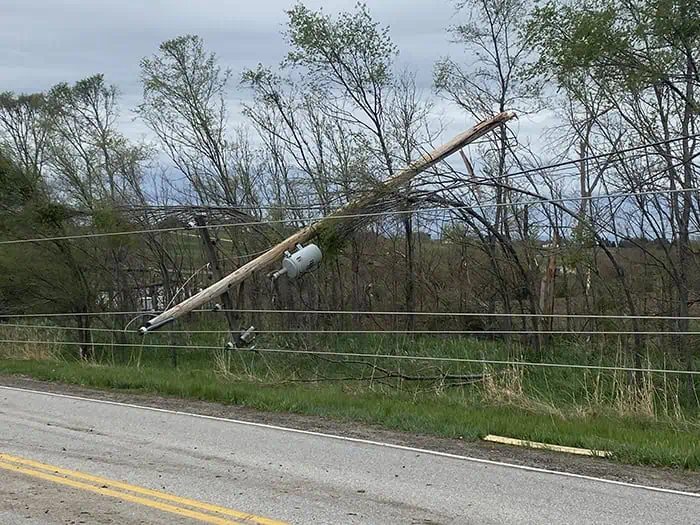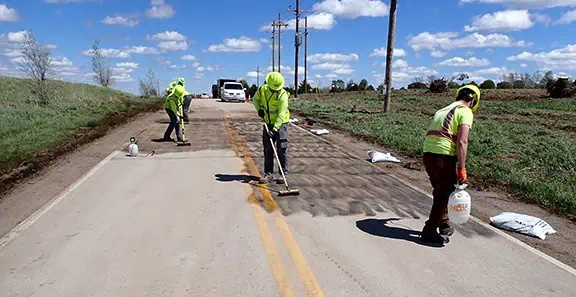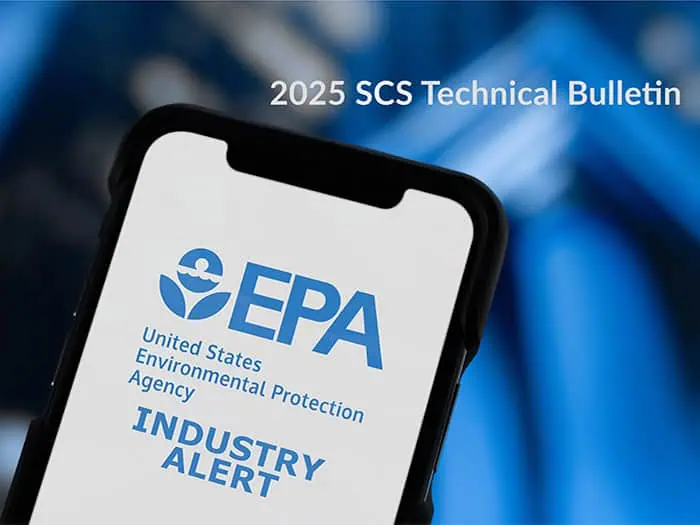

Inclement weather, such as high winds, heavy rain, flooding, and extreme temperatures, impacts power companies through physical infrastructure damage, increased demand, and environmental vulnerabilities. Strong winds can topple poles and trees, flooding can damage substations, heat can cause equipment to overheat, and power lines can snap.
Power companies across the U.S. use environmental engineers for many functions, such as ensuring compliance with regulations, managing waste, designing systems to minimize environmental impact, and conducting environmental assessments to mitigate impacts from storms and natural disasters.
Omaha Public Power District (OPPD) has proactive measures to protect its infrastructure and the environment from inclement weather. The protections include strengthening generation sources, regular maintenance, vegetation management, and partnering with SCS Engineers for environmental assessments and remediation.

Mineral oil is an electrical insulator and cooling agent inside power transformers. It serves as an excellent electrical insulator and a highly effective cooling agent. It prevents electrical discharges and short circuits between components while absorbing and dissipating the heat generated during operation. While a good solution for extreme weather, careful handling is critical should a transformer be damaged, which is why OPPD relies on SCS to quickly and effectively assess and remediate storm damage in the surrounding environment.
Spills happen suddenly. When they do, the SCS team is on call to assess, contain, and remediate an affected area. The remediation process involves cleaning surfaces, removing contaminated soil, and restoring the spill site, all while working to minimize power disruptions for local families and businesses. Our decades-long partnership stems from our environmental expertise and rapid response to help OPPD maintain reliable service, upholding its customer commitment to quality service and the environment.

There’s no escaping Mother Nature – extreme weather events will continue to affect Omaha through increasing risks of flooding, severe thunderstorms, and extreme heat, driven by changing precipitation patterns and the urban heat island effect. These storms bring damaging winds, hail, and tornadoes, as seen in recent years, and can damage power company infrastructure. Knowing you have an environmental steward behind your power company demonstrates Omaha Public Power District’s social commitment to its community.
Additional Resources:

The U.S. Environmental Protection Agency’s (EPA) Office of Land and Emergency Management (OLEM) announces it is updating guidance for addressing residential lead exposures at Comprehensive Environmental Response, Compensation, and Liability Act (CERCLA) and Resource Conservation and Recovery Act (RCRA) sites.
The new directive for investigating and cleaning up lead in residential soil at contaminated sites emphasizes early collaboration with state and local partners to protect communities. You should consider this as a directive for all sites with residential lead contamination subject to CERCLA response and RCRA authorities, including federal facility cleanup programs subject to CERCLA Section 120, and potentially by federal agencies using response action authorities delegated to them under Executive Order 12580.
This Directive supersedes the January 2024 Updated Residential Soil Lead Guidance for CERCLA Sites and RCRA Corrective Action Facilities in addressing lead contaminated soil on residential properties at CERCLA and RCRA sites.
The agency’s new guidance aims to address inefficiencies which slow progress to decrease lead exposure in residential neighborhoods at Superfund and hazardous waste sites. The updated directive establishes the following:
EPA will continue to use site-specific factors, including exposure considerations, soil lead background levels and community input, to make informed decisions on how to address lead exposure at each site.
The announcement on October 20, 2025, also includes a series of process improvements to accelerate response actions that address lead contaminated soil on residential properties including more nationally consistent cleanup decisions, early engagement with state and local partners, sharing best practices through the establishment of a National Center of Excellence for Residential Lead Cleanups, and specialized contracting mechanisms to leverage removal and remedial actions.
EPA plans for a roadmap for response action decision-making at residential properties and other high impact areas for children (e.g., schools, playgrounds). EPA defines residential properties as any area with high or unrestricted accessibility to sensitive populations (e.g., young children less than 7 years old) and includes, but is not limited to, properties containing single- and multifamily dwellings, apartment complexes, vacant lots in residential areas, schools, daycare centers, community centers, playgrounds, parks and other recreational areas, green ways, and any other areas where young children may risk exposure to site-related contaminated media. The roadmap will include engineered and non-engineered approaches.
Establish a National Center of Excellence for CERCLA Residential Lead Cleanups as a centralized resource to share expertise across regions, identify and facilitate efficiencies, and establish best management practices across all phases of characterization and cleanup.
CERCLA five-year reviews (FYRs) remain an essential statutory tool to evaluate protectiveness of both engineered and non-engineered remedy components at any site where hazardous substances, pollutants or contaminants remain on site above levels that permit unlimited use and unrestricted exposure, per CERCLA Section 121(c) and 40 CFR Part 300.430(f)(4)(ii). The findings of a FYR may result in the need for further evaluation, cleanup and/or institutional controls to support short- and/or long-term protection.
Additional Resources:
The upcoming round of EPA Brownfields Multipurpose, Assessment, RLF, and Cleanup (MARC) Grant applications is your community’s final opportunity to benefit from expanded funding through the Bipartisan Infrastructure Law (BIL). With this expanded support ending, competition is expected to be intense, and future grants could be smaller and scarcer.
Don’t miss this critical moment to secure transformative resources for revitalization and economic growth. Partner with SCS and start preparing your application now to stand out and make an impact.
EPA anticipates issuing the following solicitations for funding in fall 2025:
Let’s lay the groundwork today, so you’re ready when it counts. Reach out to SCS to start building your competitive, on-time application. After you contact us, one of our grant experts will reach out to schedule a virtual meeting.
The strongest applications don’t come together overnight. They are forged well in advance through strategic planning and expert insight.
At SCS, we guide our clients through every step of the process, helping you confirm eligibility, craft a compelling story, and compile the documentation that makes your application stand out. Our team has a strong track record of securing Brownfields funding for communities nationwide. When you work with us, you’re not just meeting deadlines but increasing your chances of success.
MARC Grant Funding Resources:
Per- and polyfluoroalkyl substances (PFAS), also referred to as “forever chemicals”, pose serious health and environmental risks due to their long-lasting nature, harmful effects, and widespread application across diverse industrial and commercial sectors. Exposure to PFAS has been linked with several forms of cancer and immune suppression, as well as thyroid gland dysfunction and developmental delays (EPA, 2023). These risks have prompted heightened scrutiny from regulators and have become a source of concern for stakeholders, including communities, developers, and businesses
Risks – PFAS Site Assessment
For stakeholders involved in real estate acquisitions, manufacturing, or land development, the potential presence of PFAS contamination represents a significant environmental business risk, particularly during site assessments. One of the key risks lies in regulatory liability. As environmental regulations tighten globally, businesses may be held responsible for investigating and remediating PFAS contamination even if the pollution predates their ownership. Failure to conduct thorough PFAS assessments during property transactions can lead to unforeseen cleanup costs, legal disputes, and reputational damage. Financial implications are also substantial. PFAS site assessments are complex and costly, requiring advanced sampling methods and laboratory analysis.
If contamination is found, long-term remediation efforts can span decades and impact property values, project timelines, and investment returns. Insurance coverage for PFAS-related issues is often limited, increasing the financial burden on businesses. Engaging a qualified environmental consultant before property acquisition activities is essential to managing these risks effectively. Early involvement is critical to conducting PFAS due diligence, including preliminary site assessments, data gap evaluations, and sampling programs, to characterize potential liabilities and provide the technical basis for informed investment decisions.
Also consider operational risks. Discovering PFAS contamination can delay permitting processes or halt development altogether. For manufacturers, it may lead to stricter discharge permits or operational constraints, affecting productivity and profitability. Industries such as chemical manufacturing, textiles, automotive, aerospace, firefighting, and wastewater treatment have been linked to PFAS use and discharge over the last years (ATSDR, 2022). In these sectors, proactive assessments help avoid regulatory surprises and support risk mitigation strategies.
Groundwater – PFAS Site Assessment
Some states have developed groundwater standards that differ from federal drinking water limits. Technically, when PFAS levels exceed drinking water thresholds but remain under state groundwater standards, delaying immediate cleanup is possible and safe. However, such findings signal potential liability, particularly as regulations evolve or litigation arises (ITRC, 2021).
Businesses are encouraged to incorporate PFAS evaluations into their environmental due diligence protocols to address PFAS-related risks proactively. Diligence includes engaging experienced environmental consultants, staying informed about evolving regulations, and transparently communicating findings with stakeholders. As legal and regulatory requirements tighten, proactive site assessment has become critical to responsible environmental management and risk reduction. These practices support compliance and contribute to long-term sustainability and organizational resilience.
PFAS Site Assessment Sources:
Meet the Authors:
Leslie P. Smith, Ph.D., PE has over 10 years of experience, and is responsible for project management and design in the environmental engineering and remediation field, which of environmental site assessments, soil and groundwater remediation design and implementation, drainage assessment plans, soil management plans, construction dewatering permitting, technical writing, includes client relations, contract management, project strategy development, regulatory interaction, e client relations, contract management, project strategy development, regulatory interaction and quality assurance. Reach out to Leslie on LinkedIn.
Natalia Marquez is responsible for project support in liquids management and environmental services. She works on diverse projects both performing field activities and soil and liquids management, remediation, environmental assessments, data management, and technical writing. Natalia has also acted as Assistant Project Manager on complex projects managing field activities, scheduling, and reporting. Reach out to Natalia on LinkedIn.

On September 17, 2025, the U.S. Environmental Protection Agency (EPA) announced the next steps regarding regulatory efforts to address the cleanup of perfluorooctanoic acid (PFOA) and perfluorooctanesulfonic acid (PFOS). In the press release, EPA Administrator Zeldin said, “…we will need new statutory language from Congress to fully address our concerns with passive receiver liability.”
CERCLA imposes broad, retroactive, and potentially costly strict liability on those who release hazardous substances to the environment. This liability can sometimes attach to entities that did not manufacture or generate the substance but received it in feedstocks, products, or landfilled waste. The EPA refers to these entities as “passive receivers.” Members of Congress received testimony and input from various industries, including private and municipal landfills, and passed it to the EPA, which intends to continue working with Congress. No workshops or additional input forums were announced.
The major concern for passive PFOA and PFOS contamination receivers, including local municipalities and service providers, is potentially passing decontamination costs onto ratepayers, taxpayers, and consumers. EPA will continue to collect information on its costs and benefits, but feels the best solution to this issue is a statutory fix to protect passive receivers from liability.
For now, EPA is retaining the Comprehensive Environmental Response, Compensation, and Liability Act (CERCLA or Superfund) hazardous substance designation for PFOA and PFOS and will initiate future rulemaking to establish a uniform framework governing the designation of hazardous substances under section 102(a) of CERCLA moving forward. The current rule mandates reporting of releases of one pound or more of PFOA or PFOS within 24 hours. It designates Perfluorooctanoic Acid (PFOA) and Perfluorooctane sulfonic Acid (PFOS) as CERCLA hazardous substances. See 42 U.S.C §9602; Docket EPA-HQ-OLEM-2019-0341.
According to the EPA, a CERCLA section 102(a) Framework Rule would provide a uniform approach to guide future hazardous substance designations, including how the agency will consider the costs of proposed designations. Section 102(a) gives the EPA authority to designate additional hazardous substances beyond those listed under the other statutes referenced in CERCLA (the Clean Water Act, the Clean Air Act, the Resource Conservation and Recovery Act, and the Toxic Substances Control Act). Once finalized, the 102(a) Framework Rule would provide a uniform approach for future designations.
In response to the EPA’s August 26, 2022, proposed rule to list PFOA and PFOS as CERCLA hazardous substances, numerous comments were submitted requesting that the final CERCLA HS rule include exemptions or similar liability relief for passive receivers that did not generate the chemicals – e.g., landfills, wastewater treatment facilities, and water supply systems.
Background
EPA’s May 8, 2024, final CERCLA HS rule did not provide an exemption. However, EPA’s April 19, 2024, Memorandum entitled “PFAS Enforcement Discretion and Settlement Policy Under CERCLA” outlines enforcement discretion considerations for the following entities:
(1) Community water systems and publicly owned treatment works (POTWs)
(2) Municipal separate storm sewer systems (MS4s);
(3) Publicly owned/operated municipal solid waste landfills;
(4) Publicly owned airports and local fire departments; and
(5) Farms where biosolids are applied to the land.
Despite the enforcement discretion policy, some passive receivers were disappointed that the agency did not provide stronger liability protection. Based on EPA’s September 2025 press release (above), EPA now plans to take a closer look at the issue, including the possibility of providing a statutory fix to protect passive receivers from liability.
If you have questions regarding this rule, please get in touch with SCS Engineers.
SCS Engineers is proud to take part in Engineering Career Night at Messiah University.
This event provides students the opportunity to network with industry professionals, attend targeted workshops, and explore career paths across engineering disciplines. Join us in Brubaker Auditorium at the Eisenhower Campus Complex to connect with our team and learn more about internships, co-ops, and full-time roles with SCS Engineers.
At SCS, we combine engineering expertise with a passion for sustainability—delivering innovative solutions in solid waste management, renewable energy, remediation, and infrastructure. We look forward to meeting students who are ready to plan their careers and make an impact in their communities.
SCS Engineers is excited to attend Day 2 of the upcoming career fair focused on Architecture, Construction, and Structural Design and Engineering roles!
With more than 50 years of experience, SCS provides innovative environmental engineering and consulting services in solid waste management, renewable energy, remediation, and sustainable infrastructure. We’re looking forward to connecting with students and alumni across 11 colleges and 190+ degree programs who are eager to explore careers that combine engineering expertise with real-world impact.
Join us on Day 2 to learn more about internships, Co-Op placements, and full-time opportunities at SCS Engineers. Whether you’re just beginning your journey or preparing for your next step, you’ll find exciting ways to grow your career while making a positive difference for communities and the environment.
Join SCS Engineers at the University of Wisconsin-Platteville 2025 Fall Career & Internship/Co-op Fair September 24, 2025. Session 1: 9 a.m.–noon | Session 2: 3–6 p.m. Register now!
The Clean Water Act (CWA) specifies various technology-based Effluent Limitations Guidelines (ELGs) for direct and indirect dischargers. These ELGs include:
EPA evaluated available technologies to treat or remove meat and poultry (MPP) pollutants individually and in treatment trains, as shown below in subsections, based on the type of pollutant removal, including conventional pollutants, phosphorus, nitrogen, pathogens, and chlorides.
Conventional Pollutant Removal
MPP process wastewater contains oil & grease, TSS, and BOD, all conventional pollutants removed with primary treatment, which removes floating and settle-able solids. Typical treatment technologies include screening and DAF.
Facilities may add polymers, flocculants, and phosphorus-precipitating chemicals to or before the DAF. The chemical addition increases the removal of pollutants from the wastewater. Adding chemicals to remove phosphorus can help facilities meet phosphorus effluent limits. Chemical addition may not be possible for facilities that recycle materials from the DAF to the facility, as this would contaminate the raw material.
Biological/Organic Pollutant Removal an Attractive Option
Biological, physical, and chemical processes remove BOD, nitrogen, and phosphorus. Biological processes are useful to achieve low levels of BOD and nitrogen and are common at MPP facilities. Microorganisms in biological wastewater treatment require phosphorus for cell synthesis and energy transport, typically removing 10 to 30 percent of influent phosphorus. Through biological treatment, organic compounds break down with bacteria into water, CO2, N2, and CH4 products.
Biological treatment systems are often used in series to achieve high nitrogen removal rates. Wastewater flows from one system to the next, with recycle streams and returned activated sludge returning to various system locations. Some examples include:
iii. Modified Bardenpho: This is a five-stage process: anaerobic, anoxic, aerobic, anoxic, aerobic, followed by a secondary clarifier. As in the Bardenpho process, mixed liquor with high nitrate levels is recycled from the first aerobic stage to the first anoxic stage, and activated sludge from the clarifier is recycled back to the influent. The anaerobic stage at the beginning of the system results in biological phosphorus removal. Phosphate-accumulating organisms (PAOs) are recycled from the aerobic stage in the mixed liquor to the anaerobic stage. In the following aerobic stages, PAOs uptake large amounts of phosphorus.
Phosphorus Removal
As mentioned in the biological/organic pollutant removal section, some phosphorus is removed in biological treatment processes. Chemical addition and/or tertiary filters achieve low phosphorus levels.
Pathogen Removal
Disinfection destroys remaining pathogenic microorganisms and is generally required for all MPP wastewater discharged to surface waters. Chlorination/dechlorination, Ultra-Violet (UV), and some filters can meet effluent limits for pathogens and inactivate pathogenic microorganisms before discharge to surface waters.
Chloride Removal
Some MPP processes, including hides processing, meat and poultry koshering, and further processing techniques, such as curing, brining, and pickling, commonly produce wastewater streams with high levels of chlorides. Some facilities use water softening, which can also produce high chloride wastestreams. Wastewater treatment technologies commonly found at POTWs and many MPP facilities do not remove chlorides. The optimal chloride treatment technologies for a facility depend on wastewater strength, climate, land availability, and cost. High chloride wastestreams may be able to be separated from other wastestreams, which can reduce costs and energy required for treatment.
Solids Handling
Some wastewater treatment technologies produce industrial sludge. In the MPP industry, DAF and clarifiers primarily generate sludge. The sludge contains oil & grease, organic materials, nitrogen, phosphorus, and chemicals/polymers added in the treatment system. The sludge may have a high water content, which can be reduced to reduce volume and save on hauling and landfilling costs. Common dewatering technologies include gravity thickening units and the belt filter press. The sludge may be incinerated, land applied, or landfilled, depending on state, local, and federal regulations and disposal method availability.
Additional Information About PFAS Removal – Foam fractionation is a separation process that leverages the affinity of certain molecules for the air-liquid interface to isolate and concentrate them. It works by bubbling gas through a liquid, causing the target molecules to adsorb onto the surface of the bubbles and rise to the top, forming a foam that is removed. This process is useful for removing and concentrating per- and polyfluoroalkyl substances (PFAS) from water and wastewater.
An energy company using coal (many still do as they transition to renewable energy sources) uses desulfurization for its flue gas, preventing air pollution and creating gypsum as a by-product. Fly ash, another by-product of creating energy, is sold to concrete companies for a profit. The wastewater used in these green processes has high chloride. It is pretreated to ensure the chemistry of the wastewater is safe before injecting it into an EPA and state regulatory agencies-approved Class I well below drinking water aquifers.
Pretreatment helps to ensure the energy company does not decrease the capacity of the well to accept wastewater. Chemical characterization of the wastewater in the permitting process and regular sampling during operations helps ensure the fluid is non-hazardous and unchanged.
Using green practices, this energy company prevents air and water pollution, protects drinking water resources, and qualifies as a zero-discharge facility. The bottom line is that they provide energy at a reasonable cost; the company is profitable from its green practices and protects health and human life.
That’s sustainability that empowers the safety of electric utilities as they provide for our energy needs.
You are welcome to make use of SCS Engineers’ extensive library of papers, blogs, and videos for the power sector. Here are a few suggestions:
